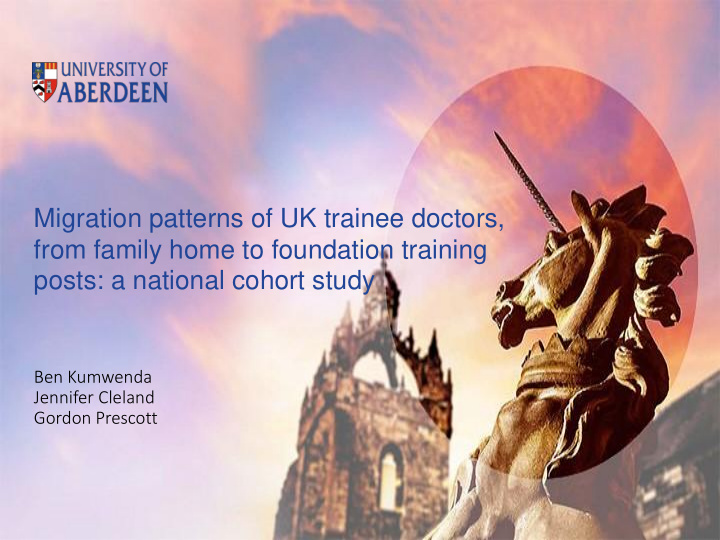



Migration patterns of UK trainee doctors, from family home to foundation training posts: a national cohort study Ben Kumwenda Jennifer Cleland Gordon Prescott
Background UK experiences geographical variations in recruitment trends • [Add your text and image(s) here] of healthcare professionals. Some areas face chronic under- recruitment. Understanding where medical graduates choose to go for postgraduate training is important because doctors more likely to consider practicing in areas where they completed postgraduate medical training.
Background • [Add your text and image(s) here] The influence of home origin is particularly important for medicine because recently there have been policy drives to address shortage of doctors in certain geographical areas.
To address these questions … • We sought to examine the relationship between foundation school locality and parental postcode, to investigate the “migration” patterns of UK medical graduates in terms of where they wish to spend their first years of postgraduate training, and how this relates to where they attended medical school.
Commonly used contextual markers • Parental occupation derived from National Statistics Socio-economic Classification (NS-SEC) • Index of Multiple Deprivation (IMD) • Participation of Local Areas (POLAR) • Ethnicity • Age (mature students) • Entitlement to Free School Meals • Income support • Type of school attended
Methods: Data Preparation We used the postcode of the administrative Unit of Application (UoA) as a centre of each foundation school. Then used a web-based distance calculator (https://www.doogal.co.uk/dri vingdistances.php) to measure the travel-time between parental home and foundation school.
Methods • Net gain or loss of trainees moving from one region of medical school to another region of foundation school. • Chi-square tests • Multilevel Modelling - Generalised Linear Mixed Model (GLMM)
Trainees’ average travel time from parental home to place of Foundation School, split by UK country.
Table 1: Driving time from parental postcode to Unit of Application (UoA) Less than 2 hrs Between 2 and 4hrs More than 4hrs p-value (n=3519, 61.9%) (n=1503, 26.4%) (n=667, 11.7%) Row % Row % Row % Type of secondary school attended State-funded 62.8 25.1 12.1 0.001 Fee paying school 59.3 30.0 10.7 Free School Meal Yes 73.9 16.1 10.0 <0.001 No 61.1 27.2 11.7 Parent Education (University degree) Yes 59.5 28.3 12.2 <0.001 No 68.7 21.6 9.7 ( Neighbourhood) of participation of higher education areas (POLAR 2&3) Low Participation 66.9 27.9 5.2 0.003 High Participation 62.1 26.6 11.4 Ethnicity Asian or Asian British 79.0 16.8 4.1 Black or Black British 61.5 29.2 9.4 Mixed 57.4 32.5 10.0 <0.001 Other Ethnic Groups 80.0 15.2 4.8 White 58.0 28.4 13.7 Domicile England 63.3 29.1 7.7 Northern Ireland 63.1 0.0 36.9 <0.001 Scotland 58.8 21.5 19.7 Wales 49.8 36.7 13.5
Multivariate analysis … • The GLMM confirms that coming from disadvantaged backgrounds (as determined by entitlement to free school meals, OR=0.786; parental education, OR=1.339 and POLAR, OR= 1.219) influences trainees’ odds of selecting foundation schools closer home. Adjusted Odds Ratio Sig Exp(Coefficient) 95% Confidence Interval for Exp(coefficient) Lower Upper No 0.005 0.786 0.664 0.930 Free School Meal Yes* No <0.001 1.339 1.227 1.460 Parent Degree Yes* Low Participation 0.041 1.219 1.008 1.474 POLAR High Participation* Asian or British Asian <0.001 2.406 1.798 3.219 Black or Black British 0.442 1.22 0.733 2.035 Mixed 0.915 0.988 0.795 1.229 Ethnicity Other Ethnic Groups <0.001 3.010 2.092 4.329 White*
Conclusions The finding has implications for both the widening access agenda and equitable distribution of health services. • Firstly, the result reaffirms the assumption that widening participation has the potential for recruiting medical graduates who are more likely to train local and remain in the area to serve their communities. • Secondly, medical education and training is a complex institution that transcends beyond the borders of UKs devolved governments; therefore, understanding the migration pattern by which medical graduates enter the profession could provide useful information for workforce planning, as well as adding voice to the national debate about funding in the devolved nations.
Thank You
Recommend
More recommend